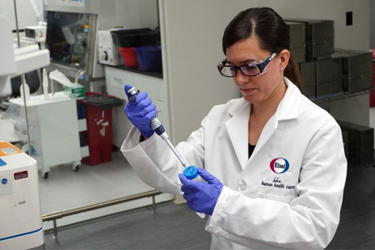Leveraging Genetics To Inform Clinical Trials And Drug Development In Alzheimer's Disease
By Janna Hutz and Michael Nagle, Eisai Center for Genetics Guided Dementia Discovery (G2D2), and Larisa Reyderman, Alzheimer’s Disease Brain Health, Eisai

At the Eisai Center for Genetics Guided Dementia Discovery (G2D2), our discovery process starts with human genetics as we aim to better understand the genesis of dementia, including Alzheimer’s disease (AD). A chronic neurodegenerative disorder, AD is characterized by a build-up of toxic protein aggregates called amyloid plaques and tau tangles that lead to progressive damage to brain cells and brain shrinkage.1 For AD in particular, genomic research over the last decade has determined that genes that are expressed in microglia – the resident immune cells in the brain – are important in both gauging an individual’s risk for developing AD and influencing progression of disease.2
Our team at G2D2 regularly evaluates the latest published genetics studies across disease indications to glean new insights on mechanisms of pathogenesis and progression. Each week, geneticists on our data science team review and assess new findings that surface in the fields of genetics and dementia. With each publication, we are closer to understanding the connections between genetic variants and disease. For example, a recent genetics study in almost 800,000 individuals highlighted 75 genomic regions associated with AD and related dementia risk, 42 of which were new at the time of analysis.3 By expanding the number of known genomic loci that are associated with AD, there is a greater opportunity to evaluate novel targets and mechanisms for therapeutic intervention, as well as tools that can better identify populations with elevated genetic risk of developing AD. 3
Ensuring Genetic Findings Represent Real-World Patient Populations
To ensure the insights we glean from genetic studies are relevant and reflective of the population affected by a particular disease, such as AD, it is important that we look to genetic studies that are inclusive of diverse groups. Fortunately, the number of studies evaluating AD genetics in non-European populations is on the rise, offering important insights into the disease. Since Eisai is a global pharmaceutical company that conducts international clinical trials, the diversity of our trial participants also brings opportunities to learn about the genetics of AD in global populations.
At the 2022 Alzheimer's Association International Conference, several presentations addressed the genetics of AD in Caribbean Hispanic, African American, and other underrepresented populations, highlighting the importance of identifying novel variants associated with disease from diverse populations and understanding their pathogenetic mechanisms. In addition, a number of the presenters highlighted the importance of generating polygenic risk scores (PRSs) to define risk of AD in diverse populations, as PRS scores defined in European populations have frequently failed to translate to populations of different genetic architectures.
In a recent peer-reviewed scientific publication, the authors show how developing a PRS for AD risk, incorporating the apolipoprotein E (APOE) gene region and other germline genetic variants separately, has the best predictive power and is replicable across populations.4 This is an important advancement in AD disease prediction and has the potential for use as a means to identify individuals at high risk for AD before they show any disease symptoms, or even before they’ve been screened for any prodromal biomarkers. As the number of these diverse studies increases, the predictive power of genetics for AD may also become more precise and better serve these populations in understanding their disease risk.
Utilizing Genomic Research To Inform Clinical Studies
It is through studies like these that we are able to accelerate precision therapeutics with the ultimate goal of treating the underlying cause of AD. At its core, our AD research seeks to understand and employ the use of biomarkers for the diagnosis and staging of AD and as a robust indicator of treatment effect. We are looking to precisely define patients who would be most likely to respond to treatment. Additionally, biomarkers are used to demonstrate the biological effect of treatment on AD pathology. With this research we are building clinical trials that explore the biomarker and clinical effects of stopping and restarting treatment with a given compound to understand predictability and durability of potential therapies across the disease trajectory for patients with AD. We can combine genomic biomarkers with other fluid biomarkers including 42 amino acid-long amyloid-beta peptide (Aβ1-42), total tau protein (t-tau), and tau phosphorylated at threonine 181 (p-tau18)5 in clinical trials to identify individuals who may be most responsive to treatment, as well as to demonstrate how individuals respond to treatment and which treatment works best for those individuals.
Genetics studies are not just useful for understanding AD pathophysiology and identifying new therapeutic targets for AD but also have been used to better understand other common chronic diseases, including type 2 diabetes and rheumatoid arthritis. Indeed, applying the same approaches to other disease areas may lead to the discovery of novel target mechanisms as well as better defined target populations.
Because genetics gives us greater insight into what causes disease versus how the body changes in response to a disease, we’re able to have more confidence in selecting targets for therapeutic modulation based on genetic evidence. With this research, we are working to identify new targets and develop new hypotheses that will help address the world’s great unmet need for breakthrough dementia therapies.
References:
- National Institute on Aging [Internet]. Gaithersburg: The Institute; c2017 [cited 2023 March 7]. What Happens to the Brain in Alzheimer's Disease? Available from: https://www.nia.nih.gov/health/what-happens-brain-alzheimers-disease.
- McQuade A. and Blurton-Jones M. Microglia in Alzheimer’s disease: Exploring how genetics and phenotype influence risk. J Mol Biol. 2019 Apr 19;431(9):1805-1817.
- Bellenguez C. New insights into the genetic etiology of Alzheimer’s disease and related dementias. Nat Genet. 2022 Apr;54(4):412-436.
- Leonenko G. Identifying individuals with high risk of Alzheimer's disease using polygenic risk scores. Nat Commun. 2021 12, 4506
- Bouwman, FH, Frisoni, GB, Johnson, SC, et al. Clinical application of CSF biomarkers for Alzheimer's disease: From rationale to ratios. Alzheimer's Dement. 2022 14:e12314.
About The Authors:
 Janna Hutz, Ph.D., is president of Eisai’s Center for Genetics Guided Dementia Discovery (G2D2) and head of the Human Biology Integration Foundation within Eisai’s Deep Human Biology Learning R&D organization. In this role, Hutz oversees global efforts to incorporate learnings from human biology and data science to impact research decision making across Eisai’s oncology, neurology, and global health portfolio. She is the site head of G2D2, Eisai’s Cambridge, Massachusetts-based research center seeking to deliver breakthrough solutions for dementia by leveraging human genetics, data sciences, and precision chemistry.
Janna Hutz, Ph.D., is president of Eisai’s Center for Genetics Guided Dementia Discovery (G2D2) and head of the Human Biology Integration Foundation within Eisai’s Deep Human Biology Learning R&D organization. In this role, Hutz oversees global efforts to incorporate learnings from human biology and data science to impact research decision making across Eisai’s oncology, neurology, and global health portfolio. She is the site head of G2D2, Eisai’s Cambridge, Massachusetts-based research center seeking to deliver breakthrough solutions for dementia by leveraging human genetics, data sciences, and precision chemistry.
Before joining Eisai, Hutz worked at Pfizer, applying human biology findings to support discovery and clinical programs in immunology. She completed a postdoctoral fellowship at the Novartis Institutes for Biomedical Research after receiving a Ph.D. in quantitative human and statistical genetics from Washington University in St. Louis and a B.S. in cellular and molecular biology from the University of Michigan.
 Michael W. Nagle serves as sr. director, head of human genetics and causal biology at the Eisai Center for Genetic Guided Dementia Discovery (G2D2), located in Cambridge, MA. In this role, he directs the development of the human genetics strategy for the company’s Deep Human Biology Learning (DHBL) R&D organization and leads a team of geneticists and informaticians who provide expertise and support to their Eisai colleagues toward the strategy’s implementation.
Michael W. Nagle serves as sr. director, head of human genetics and causal biology at the Eisai Center for Genetic Guided Dementia Discovery (G2D2), located in Cambridge, MA. In this role, he directs the development of the human genetics strategy for the company’s Deep Human Biology Learning (DHBL) R&D organization and leads a team of geneticists and informaticians who provide expertise and support to their Eisai colleagues toward the strategy’s implementation.
Nagle’s key responsibilities include target identification and validation, biomarker discovery, and clinical trial patient stratification and design strategies. To assist in the implementation of the human genetics strategy and goals, he develops and assists in managing an internal infrastructure for computation and analysis, which identifies, internalizes, and analyzes key data for stakeholders throughout the organization.
 Larisa Reyderman is vice president clinical pharmacology & translational medicine at Eisai Inc., where she leads a global team that includes clinical pharmacology, pharmacometrics, translational medicine, and imaging supporting Eisai’s neurology portfolio.
Larisa Reyderman is vice president clinical pharmacology & translational medicine at Eisai Inc., where she leads a global team that includes clinical pharmacology, pharmacometrics, translational medicine, and imaging supporting Eisai’s neurology portfolio.
